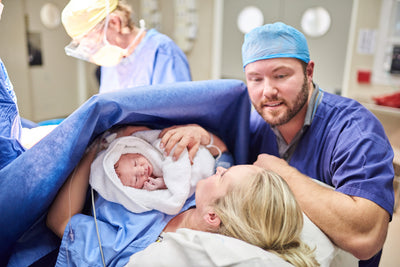Towards the end of your pregnancy your body will be making many subtle changes to prepare you to birth your baby. You may or may not notice all of these changes, as every woman is different and every labour and birth can be different, too.
During your pregnancy, your cervix is long, thick and firm, securing the entrance to your uterus to protect your baby. Leading up to and during labour your cervix begins to soften and thin down in preparation to open and birth your baby.
Whilst your body is preparing you for the birth with hormonal changes, you may experience some of the following symptoms:
The Show (The operculum)
This is a mucous plug that seals the opening of the cervix during your pregnancy to help protect your growing baby. When the cervix begins to soften, this plug may start to be released - usually coming out in bits rather than in one whole piece. Although the mucous looks clear and jelly-like, it can often be tinged pink and blood-stained due to some bleeding from the cervix.
If there is a lot of blood (like the amount you might have during a heavy period), contact your hospital as this is not a normal amount and you will need to be seen by the medical team as soon as possible.
Backache
You might think that your heavily pregnant bump is causing you more backache than usual but, when labour is beginning, it can often start as backache which comes and goes, similar to the pattern of contractions.
Try some pressure or massage from a birth partner to help relieve this or use a warm wheat bag or hot water bottle on the area. If you have a TENs machine, now is a good time to start using this, starting on a low setting and turning it up gradually as needed.
Braxton Hicks (practice contractions)
Your uterus is a muscle and it starts to tone up in pregnancy in readiness for labour and birth. You may experience what is known as ‘Braxton Hicks’ practice contractions from as early as 20 weeks of pregnancy, where you might feel your bump hardening or feeling tighter, in an irregular type of pattern.
Although Braxton Hicks are not a sign that labour is necessarily imminent, they may increase in intensity as labour starts.
Contractions
Contractions can feel like period cramps when they start. They may begin under your bump and be quite irregular at first. They can stop for hours and then restart themselves the next day or in the evening. In the early stages of labour they often vary in length and strength, too, before your uterus gets into a more regular and rhythmic pattern.
For first time mums your contractions should be coming approximately every 3 minutes in a regular pattern for labour to be established and continuous.
For second time or more mums, contractions may be slightly less frequent but, if you are unsure, call your midwife or maternity unit to discuss how you are feeling and to make a plan for your labour.
Waters breaking (spontaneous rupture of membranes)
In about 15% of women the waters will go before contractions have started. The ‘waters’ are the amniotic fluid, which surrounds your baby during pregnancy and is contained in a membrane sac, which can break before or during labour, or as your baby is being born.
If your waters break, it could be a trickle or a gush, and the fluid should be clear or straw coloured. If the waters are green or brown in colour your baby has passed meconium (baby’s first bowel movement).
If you do think your waters have broken, contact your midwife or hospital.
Nesting
Your hormones are building up and telling you to find or make a safe place for the labour and birth of your baby. Instinctively, for most people, this safe place is your home, as this is where we usually feel the most at ease. You may start tidying and cleaning, preparing a comfortable environment, cooking meals and baking, or all of these things!
Tune into your body’s cues and try to stay relaxed to optimise your body’s release of the hormones needed for your labour and birth.
Summary
Although there are several things that can take place as your body prepares to go into labour, some of the above (like the ‘show’, back ache and Braxton-Hicks) may also happen quite some time before. Instinctively, you will most likely notice a change in yourself (like the need to nest) as your body starts getting ready to labour. Your midwife and the 24-hour maternity triage centre are there to listen and support you, and to guide you regarding when to come in if you are having a hospital birth.






